|
|
Advertisement:
|
|
Asetek WaterChill |
|
Join the community - in the OCAU Forums!
|
Test Setup, Results, Conclusions
Test Setup:
I considered a couple of tower cases to build the WaterChill into, but eventually decided to be a little different and get my old Yeong Yang 0221 Cube out of mothballs. Whenever I mention this case in reviews I get people asking where to get one. Right now the only place I know that carries them is SecretNet.
Asetek recommend running the radiator on its side, with the inlet at the top of one side. However, I found that I could mount the radiator at the front of the lower drive bays in the cube case by turning it so the inlet and outlet were both at the very top. I figured a small drop in flow rate would be worth the tradeoff that the radiator is now sucking cold fresh air from outside the case. I can still install my drive bay covers for a stealthy look.
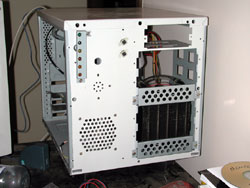 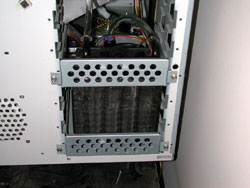
My plans to push this AthlonXP 1800+ on my ABIT NF7-S v2.0 were of course dashed by the mounting problem discussed above. A quick survey of the socketA motherboards here revealed Soltek's SL-75DRV5, based on VIA's KT333 chipset, as the next likely candidate. This motherboard is particularly roomy around the socketA and not a bad performer either. In fact, it's aged remarkably well. I reviewed it back in May 2002, but with recent BIOS upgrades it supports modern processors, allowing a range of multipliers to be chosen on the XP1800+. I was even able to run it stably at 166MHz FSB using the jumpers, a setting that had attracted some interest when this board was released, but I was unable to test at the time. However, the maximum multiplier selectable is 12x. 12x166 gives us 2GHz, which is a fair way above the 1533MHz default, but I have seen this CPU do 2.4GHz with an aircooler. So, we'll have to wait for the new WaterChill CPU block lid, which fits the NF7-S, before we can go pushing any overclocking limits. However, we can see how well this system cools our CPU at 2GHz and, to spice things up a bit, 1.75v core, up from 1.5v default. The AGP port is well out of spec at this FSB also due to the lack of an appropriate divisor, so I'm using a PCI card for the moment. No matter, we can still stress the CPU.
When I first fired up the system, the 1800+ was idling at 66C. This was much higher than you would expect even with the stock air-cooler, so I hurriedly powered down. The manual says to screw the top fitment down until it contacts the metal rod. This is difficult to see with the springs in the way, so I figured when I could no longer turn it, it would be firmly contacting the rod. In order to stop the rod from simply rotating on the motherboard I removed the motherboard from the case again and held the rods in place with a screwdriver in the screw on the back of the motherboard. This improved things to some extent, but the system was still idling at 59C. Again Asetek support were very helpful, explaining that on some motherboards there are small components that can foul the plastic spacers and bottom springs for the waterblock. Indeed, on the Soltek there was an SMD component raising one side of one of the spacers slightly. Asetek advised me that they no longer ship the lower springs with the kit and that the upper springs will provide correct tension by themselves without causing any extra risk to the CPU core. So, I dutifully removed the lower springs and spacers, remounted the waterblock and was rewarded with a much lower idle temperature. On with the testing!
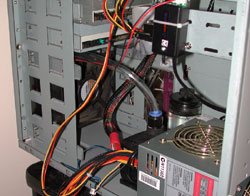 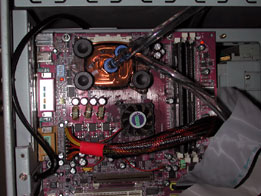
Performance Comparison
With the range of products available now, an enthusiast could almost certainly build a watercooling system which is more efficient than this one, given sufficient budget, knowledge and time. Larger radiators, different waterblocks and higher-flowing pumps are all available in various forms. However, it seems to me that this system is aimed more at people who want to make their first foray into watercooling. It's designed as a relatively simple solution which can be assembled with a minimum of fuss, rather than a tweaked-to-the-max high-performance system. Also, a primary motivator for people moving to watercooling nowadays is to reduce the noise of a PC. It's becoming increasingly difficult to get a highly overclocked, or even just high-powered stock machine, which doesn't emit a deafening fan roar. For these reasons, and the fact that I have no other complete watercooling systems to compare it to, we will look at how it compares to some decent air-coolers.
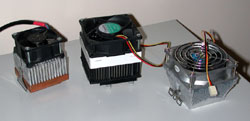
The three air-coolers in question are, from left to right above, Swiftech's MCXC370, Alpha PAL8045 (from CoolPC) and Spire's FalconRock II (from LowNoisePC). The Swiftech is a copper-based heatsink with "helicoid" ribbed aluminium pins, topped by a molex-powered 60mm fan. The Alpha is a hefty copper monster that attaches to the 4 motherboard holes like the WaterChill, with a thick 80mm fan on top. While these two aren't cutting-edge products nowadays, they're still very decent high-end coolers with a noise penalty due to their powerful fans. The Spire is much quieter and still a decent performer for the noise-conscious folk. Of course, we also tested the WaterChill in 12v and 7v modes.
To test a "full load" temperature we ran the POVRAY benchmark for 15 minutes. This is a raytracing program which locks the CPU at 100%. Just in case any idle CPU cycles slipped by, we also ran the Folding@Home client in a DOS window. After 15 minutes the temperature was recorded - all heatsinks stabilised in less than 10 minutes anyway during testing. For our idle temperature, POVRAY and F@H were closed and the system allowed to cool itself down for a further 15 minutes before the temperature was recorded. The ambient temperature was 25C and we used the onboard thermal sensor to monitor the temperature.

Bear in mind that the temperatures reported may be inaccurate and shouldn't be compared to other motherboards. We are mostly interested in the difference between the aircoolers and the WaterChill unit rather than the absolute temperatures reported.
From our results we can see the WaterChill handily beat even the much louder heatsinks from Alpha and Swiftech. The quieter option from Spire fared quite badly - it seems our overclocked and overvolted CPU was simply too much for it with the stock fan. 74C is much higher than I'd be comfortable running this CPU in the long term. It's common to see these Spire coolers with more powerful fans on them and they perform impressively with more airflow, but of course there is then more noise being produced. You will note there is only a few degrees difference between the Alpha cooler and the WaterChill, but the noise difference, especially for the WaterChill in 7v mode, is dramatic. While the WaterChill is almost silent, the Alpha's 80mm Sunon fan emits a constant low-pitched whoosh which, while not as annoying as a 60mm Delta screamer fan, is still above the level I would consider comfortable for long-term use - and it's still running 2 degrees hotter than the WaterChill.
Interestingly, there's not much difference between 12v and 7v mode with the WaterChill. Unless you are really pushing the limits with an even hotter-running CPU than our testbed, it seems unlikely you'd ever need to switch the WaterChill to the noisier 12v mode. This kind of performance from a system that is almost silent is very impressive. It will be interesting to see how the system scales with an even faster and hotter CPU, to see if the difference between the air-coolers and the WaterChill increases. I would expect the aircoolers to hit their limit before the WaterChill, but we'll have to see when the new CPU block lid arrives.
Conclusions:
The hardcore watercoolers will perhaps scoff at the notion of a newbie-friendly watercooling kit, preferring instead to hand-choose their components and opt for fancier (or salvaged from junkyard/wreckers) parts here and there. However, they are not the market Asetek is aiming at with this system. For those who have been contemplating watercooling, who want a system that can be assembled fairly simply and which offers very decent performance with low noise, the WaterChill kit seems an ideal solution.
PC Range are Asetek's Australian agent and carry the WaterChill kit for AUD $389 at the time of writing. That's certainly a lot more than even a top-of-the-line aircooler will cost you, but looking around the net a decent CPU waterblock is anything from $70-$160 by itself, with radiators a similar price or more. Add in a similarly priced pump, a reservoir, some tubing and connectors and you will be well into the same pricing ballpark if not above it. The WaterChill compares very well pricewise with other ready-to-go watercooling bundles.
Stay tuned for a followup article with Asetek's new, more compatible CPU block lid and their northbridge and GPU blocks. Asetek claim that they are also aiming at the high-performance user with this kit and we will test the WaterChill's ability to handle an extreme heat load when the new components arrive.
|
|
Advertisement:
All original content copyright James Rolfe.
All rights reserved. No reproduction allowed without written permission.
Interested in advertising on OCAU? Contact us for info.
|

|


